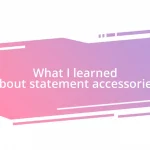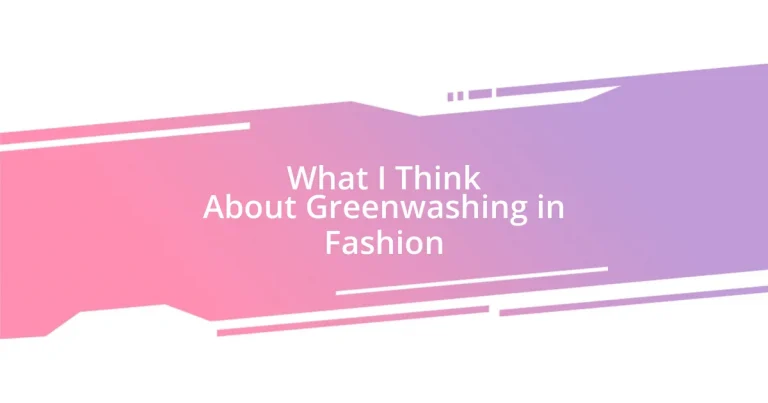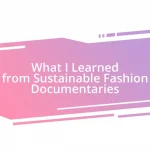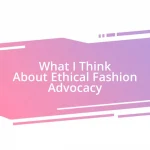Key takeaways:
- Greenwashing involves companies misleading consumers about their environmental practices, eroding trust and creating a sense of betrayal for those seeking sustainable options.
- Identifying greenwashing requires vigilance, looking for vague claims, lack of transparency, and limited sustainable offerings, which can indicate superficial marketing rather than genuine efforts.
- Advocating for transparency in fashion is crucial; supporting brands that openly disclose their practices fosters trust and aligns purchasing choices with genuine sustainability values.
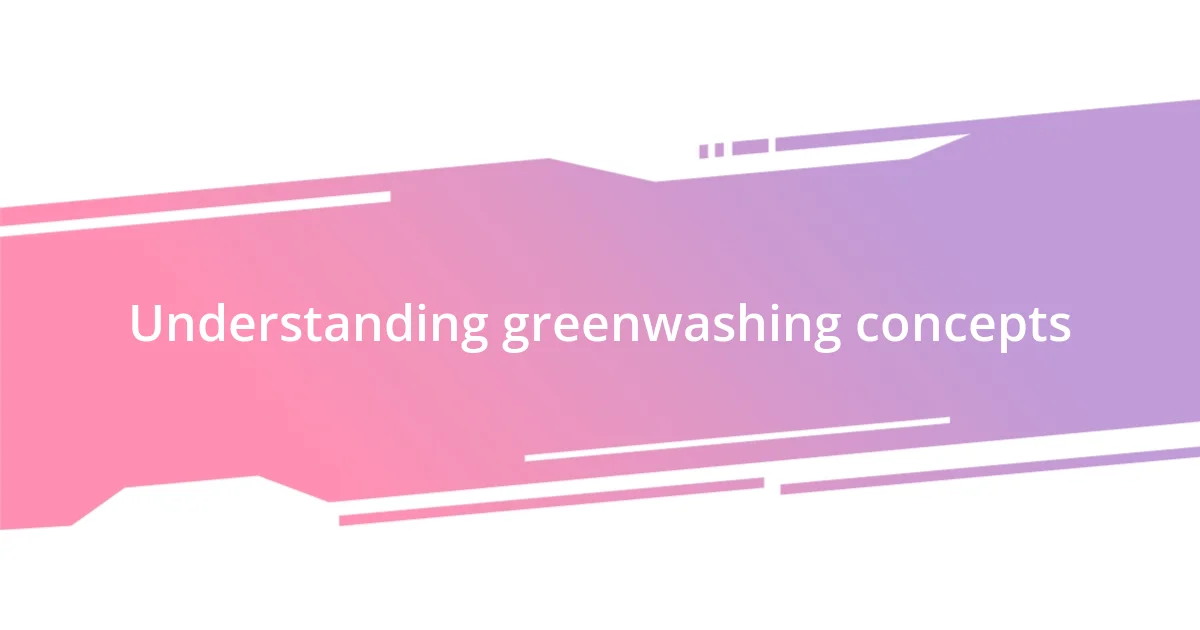
Understanding greenwashing concepts
Greenwashing is a term I’ve come to see as a sort of corporate camouflage. It refers to the deceptive practice where companies exaggerate or mislead consumers about the environmental benefits of their products or policies. Have you ever bought something thinking it was eco-friendly, only to discover later that it was just a clever marketing ploy? That realization can feel like a betrayal, and it’s becoming all too common.
To illustrate, I remember a time when I purchased a “sustainable” T-shirt from a popular brand. The label boasted about being made from organic cotton and employing ethical labor practices. However, after digging deeper, I found out that only a fraction of their collection adhered to those standards. This experience left me questioning not just that brand but the entire fashion industry’s integrity. It’s disheartening when what seems like a responsible choice ends up being more about optics than substance.
Think about it: If a brand is spending more on marketing its green efforts instead of actually implementing sustainable practices, what does that say about their values? It’s not just misleading; it can erode consumers’ trust, which is vital in today’s socially conscious market. As I reflect on my own choices, I’ve become more vigilant, seeking brands that are genuinely transparent and accountable in their environmental claims.
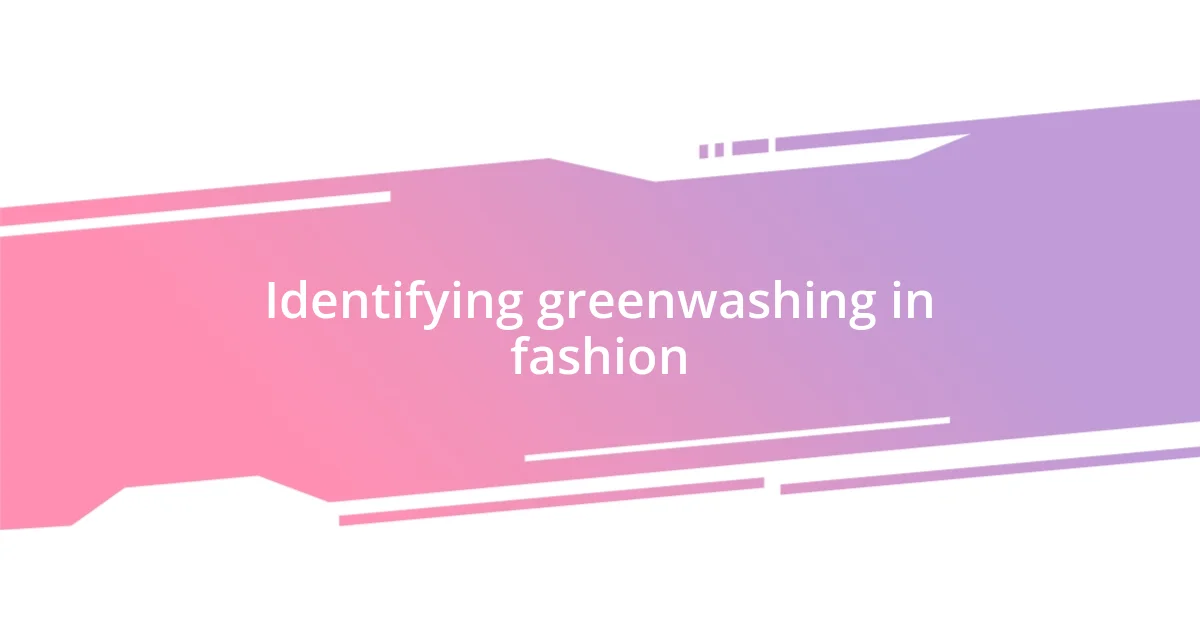
Identifying greenwashing in fashion
Identifying greenwashing in fashion requires a keen eye, as brands often employ buzzwords and imagery that create a facade of sustainability. I recall scrolling through social media and seeing ads for a new eco-friendly line of shoes that highlighted their “biodegradable materials.” Initially, I felt excited, but a brief look at their website revealed little substantiated information about their claims. It’s moments like these that remind me how critical it is to look beyond the surface.
Here are some red flags to watch for when evaluating a brand’s environmental claims:
- Vague terminology: Words like “eco-friendly” or “natural” can be misleading without clear definitions.
- Lack of transparency: If a brand doesn’t provide detailed information about sourcing, production, and supply chains, it raises suspicion.
- One-off initiatives: Companies may promote a single sustainable product while the majority of their line remains detrimental to the environment.
- Overemphasis on marketing: When a brand focuses more on advertising their green image than on substantive change, it’s a telling sign.
- Certification confusion: Some brands may display logos that look like official certifications but aren’t recognized by credible organizations.
Being aware of these indicators helps me navigate the complex world of ethical fashion and make informed choices that truly align with my values.
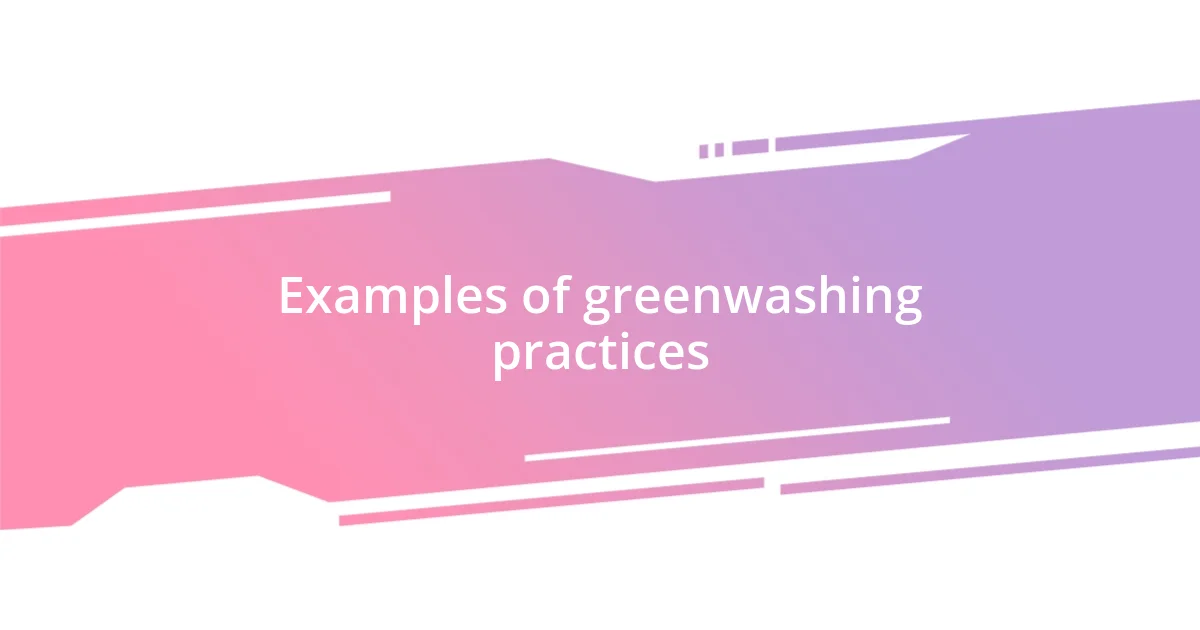
Examples of greenwashing practices
It’s truly frustrating to encounter brands that mislead consumers with their greenwashing tactics. I once spotted a popular athletic wear retailer claiming their new line was crafted from “recycled materials.” Feeling intrigued, I purchased a pair of their leggings, imagining I was contributing to sustainability. But when the shipment arrived, I was shocked to see that only a small percentage of the fabric was recycled, while the bulk was still typical polyester. That stark realization clashed with the pride I felt in my purchase, highlighting how easily I was swept into the illusion created by clever marketing.
Another glaring example occurs when a company refreshes its packaging to look more environmentally friendly. I remember a makeup brand that trumpeted its new “eco-conscious” packaging design while continuing to use unsustainable ingredients in their products. Their advertising made me feel like I was making a responsible choice, but it quickly became clear that simply changing the packaging didn’t translate to a genuine commitment to sustainability. This practice left me feeling betrayed, especially as a consumer who is actively trying to make more eco-friendly choices.
In the world of fashion, some companies promote a limited-edition collection with eco-friendly vibes, enticing consumers to jump on board. However, I recall reading about a high-end fashion label that released a “capsule collection” made from organic fabrics. What stood out, though, was that the collection was merely a small drop in an ocean of otherwise mass-produced items that lacked any sustainable standards. It made me ponder: how can we support brands that focus on ethical practices when there’s a clear temptation to skate by on surface-level efforts?
| Greenwashing Practice | Example |
|---|---|
| Vague environmental claims | Claiming “eco-friendly” without specific details on sourcing or production. |
| Misleading marketing campaigns | Promoting a line made from recycled materials while most products remain harmful. |
| Limited sustainable offerings | Introducing a small collection of sustainable items amid a broader non-sustainable range. |
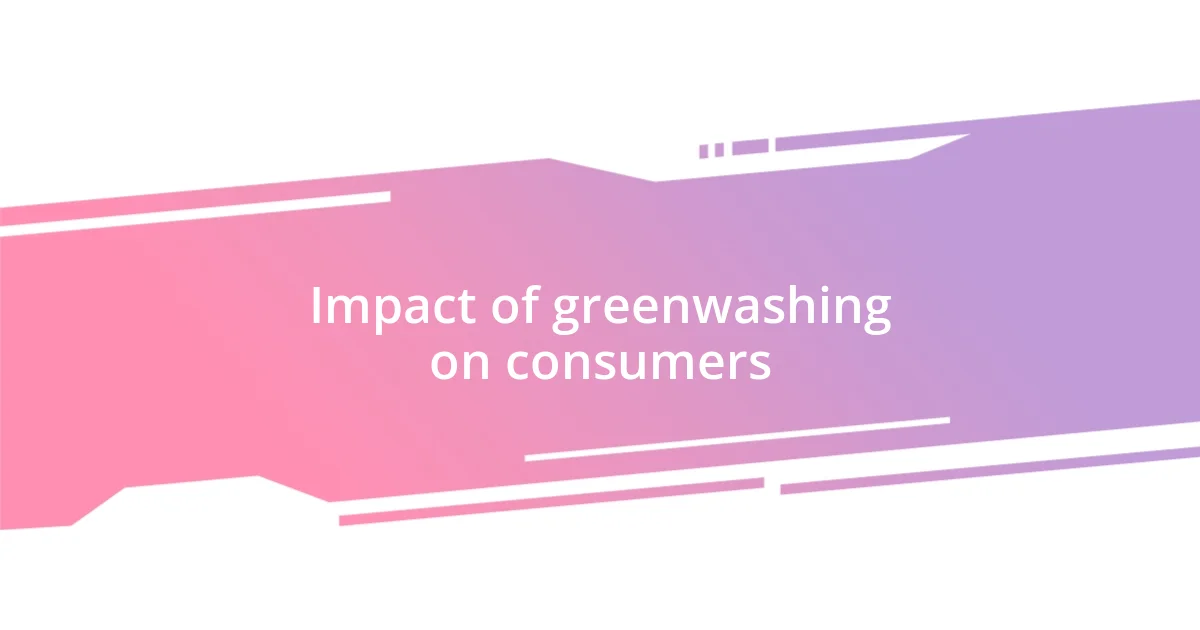
Impact of greenwashing on consumers
The impact of greenwashing on consumers can be quite profound. I remember when I purchased a jacket that boasted of being made from “sustainable materials.” I felt proud wearing it, but that pride quickly turned to disappointment when I discovered that the fabric was just a blend of conventional fibers coated with a tiny bit of recycled content. How many of us have found ourselves in such a situation, believing we’re making responsible choices only to realize we’ve been misled?
Consumers exposed to greenwashing often experience a sense of betrayal. It’s disheartening to think you’re supporting a cause, only to uncover the truth behind a brand’s facade. I felt this weight when I learned that my favorite activewear company was involved in promoting a sustainable image while contributing to poor labor practices. It made me reevaluate not just my purchasing habits, but also what kind of message I was sending with my wallet. Do you ever consider the broader implications of your fashion choices?
This type of deception creates a chilling effect on genuine sustainability efforts. When brands exaggerate their green credentials, it’s not just the individual consumer who suffers; it diminishes trust across the board. I’ve found myself hesitating to engage with new eco-friendly brands because I’m wary of falling for another marketing ploy. It raises an essential question: how can we cultivate a sense of authenticity and trust in the fashion industry when greenwashing is so prevalent? The experience has made me more discerning, but it shouldn’t have to come at the cost of feeling hopeful about sustainable fashion.
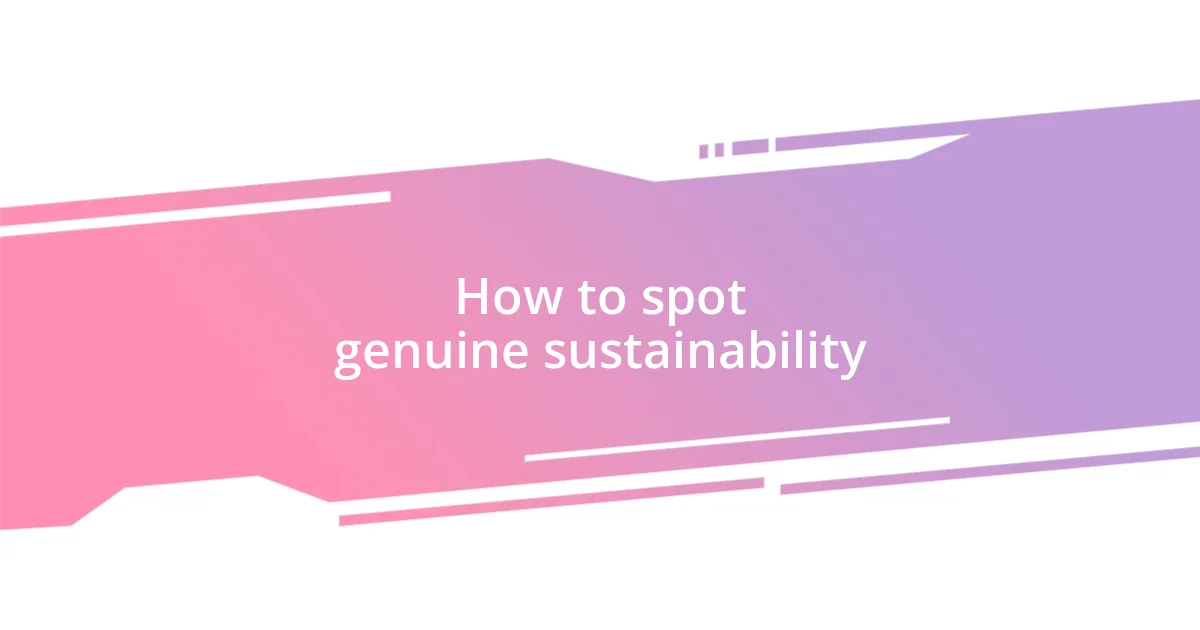
How to spot genuine sustainability
When I’m looking to spot genuine sustainability, there are a few key things I pay attention to. I remember browsing a brand’s website and noticing they provided extensive details about their supply chain. They didn’t just say their materials were “eco-friendly” — they explained the sourcing process and even shared third-party certifications. This transparency is a huge red flag if missing; companies should be proud to showcase their sustainable practices.
Another indicator of authenticity is the overall brand ethos. I once stumbled upon a small fashion label that not only sold eco-conscious apparel but also actively engaged in community initiatives, such as local workshops on sustainable fashion. Their commitment felt real because they weren’t just focused on profits; their brand wholeheartedly embraced sustainability across all aspects of their operations. Doesn’t it feel better to support brands that walk the talk?
Lastly, I’ve learned to be wary of brands that promote “limited edition” sustainable collections while ignoring their broader impact. I vividly remember a time when I almost purchased a trendy eco-friendly tote from a company known for its mass-produced items. However, a little digging revealed that their regular collections were packed with unsustainable practices. It made me ask: if a brand is genuinely committed to sustainability, why is their primary product line still so harmful? Trust your instincts!

Steps to make informed choices
To make informed choices in fashion, it’s crucial to dig deeper than surface-level claims. I often start by examining the materials used in a product. One time, I was drawn to a pair of shoes labeled as “organic cotton,” but when I looked up the specifics, I found that only the laces were organic, while the rest was made from conventional materials. This taught me to investigate beyond catchy labels—transparency is key.
Another step that has served me well is seeking out reviews or testimonials from other consumers. I recall reading a blog post from an eco-conscious fashionista who detailed her experience with a particular brand. Her insights about the quality, durability, and ethical practices of the company helped me make a more informed decision. Isn’t it reassuring to know you’re not alone in your search for sustainability?
Lastly, I embrace the power of community support. Participating in local swaps or attending sustainable fashion events has opened my eyes to brands that truly prioritize eco-friendliness. Engaging directly with founders and fellow consumers helps me feel confident in my choices. What if we all took that extra step to connect and share our knowledge? By fostering a culture of inquiry and discussion, we can challenge the greenwashing narrative together.
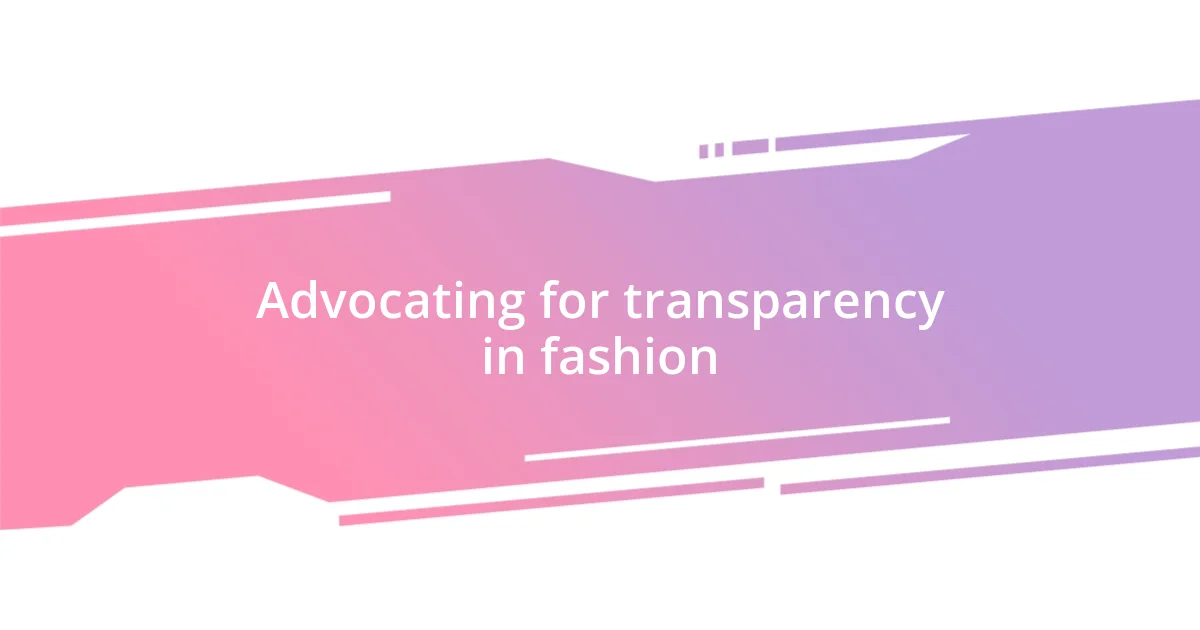
Advocating for transparency in fashion
Advocating for transparency in fashion is something I find deeply important. I’ve had moments when I felt completely lost among the plethora of brands screaming “sustainable!” Only when I actively sought out information did I realize just how essential it is for companies to reveal their processes. It’s not enough to see a green label; I want to know where that fabric comes from and who made it. Isn’t it frustrating to think you’re making a conscious choice only to discover it’s all a facade?
During my shopping journeys, I’ve come across brands that openly share their production methods, proudly displaying their factories and the workers behind the scenes. I distinctly recall a time when a brand’s website featured not just sustainability stats but actual stories of their artisans. Reading those narratives made me feel connected and invested. Imagine how empowering it is to support a brand that values transparency and honors the human aspect of fashion!
Moreover, as I discuss transparency with friends, a common sentiment rings true: it nurtures trust. I can’t help but feel a sense of camaraderie with fellow shoppers when we share brands that genuinely disclose their practices. I remember a conversation with a friend who was passionate about ethical fashion; we both felt a wave of relief when we discovered a line that practices full disclosure. Doesn’t it feel amazing to choose brands that not only tell their story but invite you into their journey? That sense of connection transforms our shopping experiences into more than just transactions; they become affirmations of our values.







